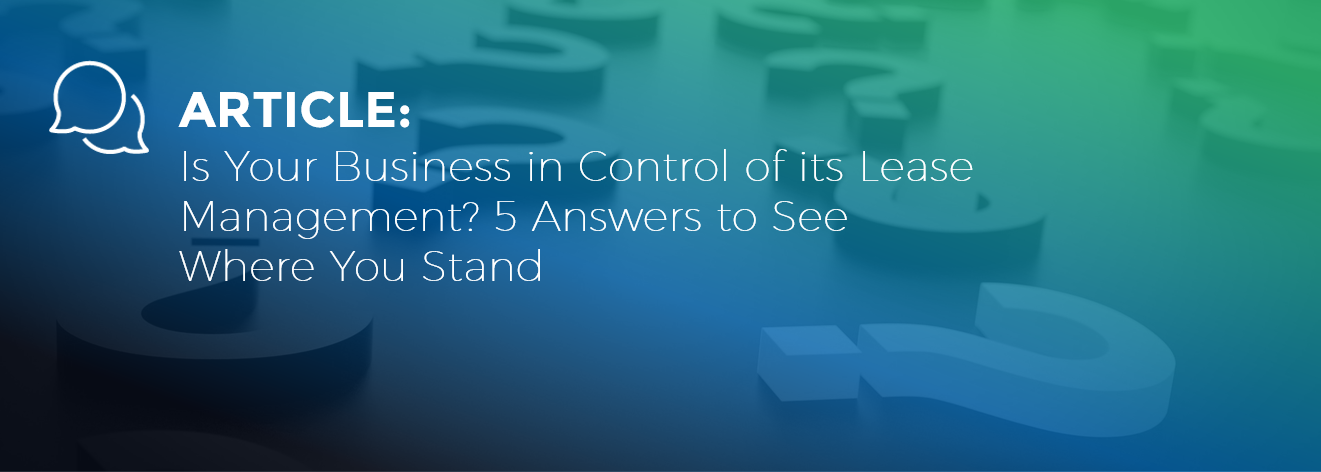BLOGS
Is Your Business in Control of its Lease Management? 5 Answers to See Where You Stand

An increasing number of organisations are choosing to lease their business assets rather than buying them outright. There are a number of advantages to this, such as less cash being needed for the initial investment, it being easier to ensure equipment is up to date, as well as certain tax benefits, depending on the tax jurisdiction.
If your business has opted to lease certain assets, whether through operating or finance leases, it’s imperative to ensure that all leases are being managed effectively. This will not only help with maintaining a clean and tidy balance sheet, it will also ensure your company is prepared with the appropriate action when leases inevitably reach their natural expiry and come to an end.
The smoother and more efficient your lease management practices, the more pronounced and visible the benefits of your leasing will be. But how can you be sure that your lease management practices are everything they should be?
In this blog, we’ll go over a few important questions you can ask to help your company review and improve its lease management and administration processes.
1. Do You Have All The Basic Lease Data Readily Available?
A well-managed inventory of all existing leases is the cornerstone of effective lease management. Organizations that have failed to maintain such a repository will inevitably spend a significant amount of time rummaging around trying to find this lease agreement or that, which is especially frustrating when the need for a certain document is urgent and you simply don’t have time to spare.
The best way to ensure all lease data is up to date and readily available is to centralise all relevant information, details, and documentation into a secure and easily accessible place. This is most effectively done via high-quality lease management software, like LOIS—Innervision’s Lease Optimisation and Information Software. LOIS provides you and your team with full visibility into real-time lease data.
2. Do You Know When All Your Leases Expire?
Once you have all relevant lease information in a readily available location, it’s important to review every lease for its expiry date. The last thing any business needs is the headache of unexpected lease expiration: it’s costly, time-consuming, and saps valuable resources from essential business processes that could otherwise be driving growth.
Effective lease management always requires key decision makers to be one step ahead and fully prepared for dealing with leases due to expire. This need is only magnified for companies that have a large volume of leases to manage; the greater the volume, the easier it is for a lease to slip through the cracks. Poorly managing the end of a lease—regardless of whether you want to renew it or not—can incur a number of costly fees, such as an unwanted extension to the primary lease or expensive return charges.
3. Could You Negotiate Better Terms?
Effective lease management doesn’t only involve taking stock of existing leases and being aware of their expiration dates. Rather, those are merely the prerequisite steps that are necessary before what is arguably the most important element of effective lease management: optimising leases for company growth through strategic negotiation.
When negotiating leases, keep the following pointers in mind:
- Always research prospective lessors in depth before entering negotiations, with a focus on any pending litigations, their particular payment systems, as well as general information about their business.
- If you feel that your business might need it, try to secure some flexibility in the financing terms of the lease. Flexible financing can include terms like deferring initial payment, starting with lower payments that increase over time, and allowing for additional equipment to be added to the lease at a later date.
- In many instances, leases do not require an initial down payment. If a prospective lessor insists on a lump sum upfront, make sure you have sufficient available capital; otherwise, consider alternative options.
- Remember that oral promises aren’t valid and won’t hold up in a court of law. If you think a lessor might be telling you what you want to hear, make sure to get it all in writing.
- Lastly, make sure that all stipulations in the lease are legal and in accordance with your relevant jurisdictions. Any clauses that do not comply with regulations may jeopardise the entire validity of the lease or its recognition as a lease and leave your business out in the cold.
4. Do You Have The Best Rates On Your Leases?
Before settling on a particular lease contract, consider whether you’re getting the best lease rate possible. There are a number of measures you can take to ensure this. For starters, a stringent tender process that compares at least three competing suppliers will help narrow down the field to a shortlist of high-value players—especially when combined with frequent shopping around and market testing. It can also be valuable to communicate with your professional network to learn what kinds of agreements they have, which can then act as a point of reference, as well as to use lease management software that checks the market value of a given lease rate on your behalf.
Your final rate should be an accurate reflection of the actual value of the lease to your company, including factors like lease flexibility, the type of asset, as well as the length of time your company will need the asset. While an agile tech company might prefer a higher rate with more flexibility, a long-term fixed lease may be more suitable for a manufacturing company needing expensive, heavy machinery. Remember that, when negotiating a lease rate with a prospective lessor, all of these factors can be valuable bargaining chips; for example, you may be able to reduce the duration of a lease agreement in order to secure a lower interest rate or increase the duration to reduce each rental amount.
5. Do You Have An Internal Process For Managing Leases?
If your company takes a rather laissez-faire approach to lease management, it’s worth considering the merits of a more structured system. This will not only ensure that leases are accurate and up to date, it will also guarantee that everyone in the company has easy access to the same information, follows the same processes and is on the same page.
Creating an internal system doesn’t have to be complicated and difficult, as there are numerous specialised SaaS (software-as-a-service) options available to simplify many parts of the lease management process. For example, Innervision’s LOIS has an intuitive dashboard interface that makes it easy to manage complex lease portfolios. Once your process is up and running, you will never have to worry about misplacing documents, missing a lease expiration date or paying unnecessary fees ever again.
By staying up to date with the best industry practices and leveraging the right lease management solutions, your company can drive portfolio savings and improve the way it manages its leases. If you would like to learn more about how to get more from your lease management, download a free copy of our Complete Guide to Leasing and Lease Management.










